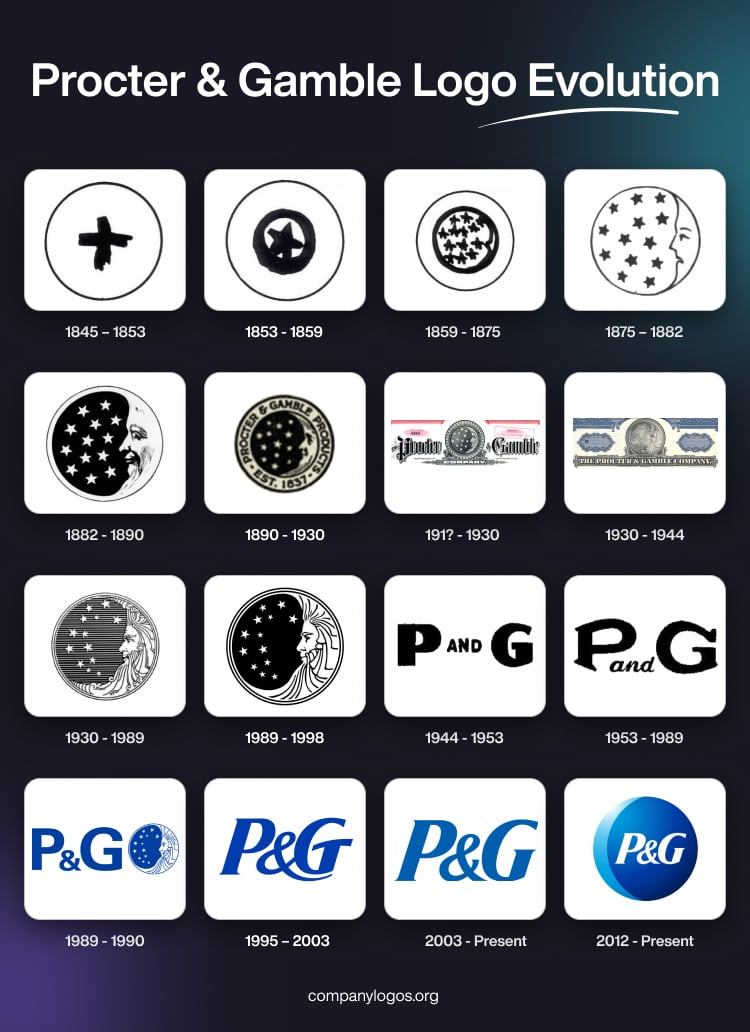
Procter & Gamble (P&G) was founded in 1837, and it is arguably one of the world’s largest consumer goods companies. The company has several well-known brands under its fold, namely, Ariel, Oral-B, Always, and Gillette. The logo of Procter & Gamble has undergone several changes over nearly two centuries. These logo changes reflect both the growth of the company and its responses to public perception. The article takes a detailed look at the evolution of the P&G logo, among other details.
The Genesis of the Procter & Gamble Logo (1837 – 191?)
Procter & Gamble was established on October 21, 1837. Its original logo is not available today, but it had the moon and stars.
(1845 – 1853)
In 1845, P&G barge workers on the Ohio River began marking cases of star candles with a crude cross to identify the company’s goods. This symbol was made into the official trademark of the company in due course.

(1853 – 1859)
In 1853, P&G introduced a new emblem: a single thick, black star within a thick circle against a white background. The two elements were enclosed within a larger circle with a thin outline in black.
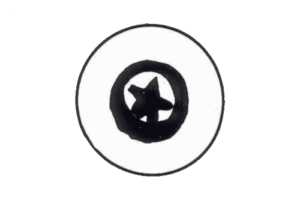
(1859 – 1875)
In 1859, the logo design evolved to include a crescent moon and 13 stars to symbolise the original Thirteen Colonies of the United States. There were also thick contours representing the visage of a man to the right.

(1875 – 1882)
In 1875, the moon-and-stars logo was refined for greater clarity and transparency. The “Man in the Moon” logo became the first widely recognised trademark of the company.

(1882 – 1890)
The moon and stars logo with the visage of a man was modified. It featured white stars against a black background and the white-and-black contours of a man’s face.

(1890 – 1930)
In 1890, the logo gained a double black outline and included the inscription “Procter and Gamble Product CST 1847” in thick, black, uppercase. The moon was thinner and nearly merged with the frame.
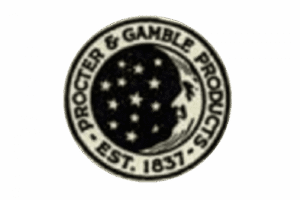
(191? – 1930)
A more stylish logo presentation came out during the period. It featured the brand name in stylish stencil lettering in black with shadows on either side of the moon and stars roundel. Below the crest-like roundel was written the word “Company” in white uppercase against a black stand.

(1930 – 1944)
The previous logo was refined by placing the brand name in white against a black scroll at the bottom. Above it was placed the crest-like emblem in a metallic colour. The logo had ornate markings at the top and sides.

(1930 – 1989)
In this logo iteration, the frame and brand name were removed. The moon’s face in the roundel was drawn with more detail, and it looked at the stars against horizontal monochrome stripes acting as the background.
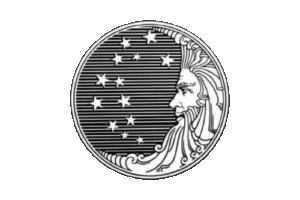
(1989 – 1998)
In 1989, the previous logo was refined further. The monochrome striped background within the double-outlined roundel was replaced by a black colour scheme.
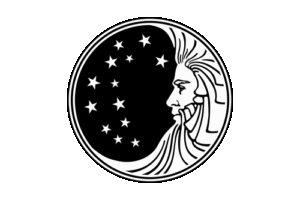
(1944 – 1953)
In 1944, the roundel was removed, and in its place came the letters “P” and “G” in extrabold, uppercase, and enlarged monochrome. Between the two letters was placed the word “AND” in black and in a small size.

(1953 – 1989)
The logo of 1953 almost retained the design and colour palette of the previous variant. However, the contours of the two letters were changed to elegant serifs. Further, the “And” was written in a cursive custom serif font in lowercase.

(1989 – 1990)
In 1989, the logo first appeared in blue and featured the letters “P&G” in a solid sans-serif typeface. The previous roundel with a moon, stars, and the visage of a man appeared to the right of the lettering in royal blue and white colours.

(1995 – 2003)
The text-only “P&G” logo became the company’s official mark to emphasise clarity and professionalism. The colour palette of royal blue and white was retained to reinforce a sense of reliability and protection. Further, the tail of the “&” sign extended to cover the letter “G”.
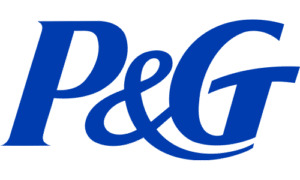
(2003 – Present)
In 2003, the “P&G” logotype in intense blue and white appeared in a slanted serif typeface to represent reliability and protection.

(2012 – Present)
In 2012, P&G unveiled a new logo designed by Landor Associates. This version featured the “P&G” logotype in white inside a slightly right-facing dark blue circle. It has a subtle light blue crescent that is reminiscent of the old moon and stars symbol. The design aimed to reconnect with the company’s heritage while presenting a modern, unified corporate image. Internally, it is called the “New Phase” logo to symbolise a new era and the phases of the moon.
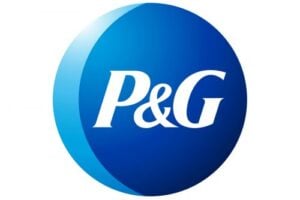
The Elements of the Procter & Gamble Logo
Font
The emblem in the Procter & Gamble logo is designed using a minimalist serif typeface, which is similar to Helvetica. The letters used in the emblem are in uppercase and italicised.
Colour
The Procter & Gamble logo employs a combination of blue (in various shades) and white.
The History of Procter & Gamble
Procter & Gamble, or P&G, was founded in Cincinnati, Ohio, in 1837 by William Procter, who was a candlemaker from England, and James Gamble, who was a soap maker from Ireland. The two became business partners after marrying sisters and being encouraged by their father-in-law, Alexander Norris, to combine their similar trades. The company began by producing soap and candles and essential commodities at the time. By 1859, P&G’s sales reached $1 million, with about 80 employees.
During the American Civil War, P&G secured contracts to supply soap and candles to the Union Army. The company introduced its products to soldiers across the country and boosted its reputation and reach. In 1879, P&G launched Ivory soap, which was an affordable product that floated in water. Needless to say, it quickly became a household staple. The company was a pioneer in employee relations. It introduced a profit-sharing programme in 1887 to align worker interests with company success and reduce labour disputes.
P&G embraced advertising early by using newspapers and later radio to market its products. By the 1920s, it had become a major international corporation with a diversified line of soaps, toiletries, and food products. In 1911, P&G introduced Crisco, the first shortening made from vegetable oils. This marked its entry into the food market. P&G revolutionised marketing by sponsoring the first radio “soap opera” in 1932. It was a move that promoted its products as well as shaped American popular culture.
The company established its first research and development lab in 1890, which led to innovations such as Tide laundry detergent (1946), Crest toothpaste (1955), and Pampers disposable nappies (1961). P&G also pioneered brand management as a business discipline in 1931. It helped the brand manage its growing portfolio of products and brands more effectively.
The company continued to innovate and launched products like Head & Shoulders shampoo (1961), Bounce dryer sheets (1973), and Always feminine hygiene products (1983). P&G expanded internationally by building factories and acquiring companies to reach new markets and diversify its offerings.
During this period, P&G entered into major acquisitions, namely, Folgers Coffee, Richardson-Vicks, Noxell (Noxzema), Shulton’s Old Spice, Max Factor, and Pantene, among others. In 2005, P&G acquired Gillette and added iconic brands like Gillette razors, Duracell, Braun, and Oral-B. It thus cemented its position as the world’s largest consumer goods company. The company continued to innovate and launch new products, such as Swiffer (1999), Febreze (1999), and Olay Regenerist (2003).
In the 2010s, P&G streamlined its portfolio by selling off or discontinuing nearly 100 brands to focus on its most profitable and globally recognised products. Today, P&G operates in over 180 countries, with a broad range of leading brands in beauty, health, fabric and home care, baby, feminine, and family care.
Interesting Facts About Procter & Gamble
- Procter & Gamble was founded in 1837 by William Procter, a candlemaker, and James Gamble, a soap maker. They were brothers-in-law who were encouraged to form a partnership by their father-in-law.
- In 1879, P&G introduced Ivory Soap, one of the first mass-produced, affordable soaps. Its unique selling point? It floated in water due to an accidental overmixing of air into the batch.
- In the 1930s, P&G created the concept of “brand management”. It revolutionised how consumer goods companies operate. They assigned individual managers to specific products, which is now a standard practice in marketing.
- To advertise its products to homemakers, P&G sponsored daytime radio dramas in the 1930s. It was a genre that became known as “soap operas” because of the soap commercials they featured.
- P&G operates in over 180 countries and owns dozens of billion-dollar brands. These include Tide, Pampers, Gillette, Head & Shoulders, Olay, and Crest.
- P&G invests billions annually in research and development and employs thousands of scientists and researchers. It even holds over 50,000 patents worldwide.
- P&G aims to power all manufacturing sites with 100% renewable electricity and use 100% recyclable or reusable packaging by 2030.
- Many successful executives started their careers at P&G. The notable names include Steve Ballmer (former Microsoft CEO) and Meg Whitman (former HP and eBay CEO).
- P&G is one of the first companies to introduce a 1-800 customer service line. This showed its commitment to consumer feedback long before it was common.
- Despite its global footprint, P&G remains headquartered in Cincinnati, Ohio, where it was founded nearly 200 years ago.
Finally
The Procter & Gamble logo and its various iterations over the years reflect the journey of the company from a local soap and candle maker to a global consumer goods powerhouse. Each logo iteration has balanced heritage and modernity, with the current logo subtly honouring its past while projecting a professional, unified image for the future.